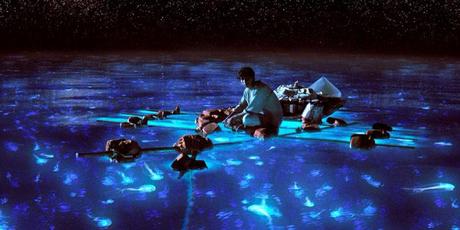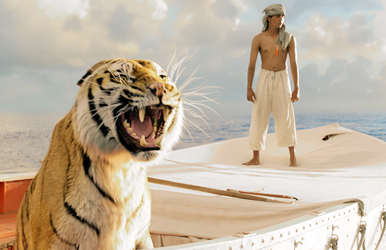‘WHICH STORY DO YOU PREFER ?’ HOW DIFFERENT CULTURES SAW ‘LIFE OF PI’ Katharine Rust | THE ATLANTIC | Feb 19 2013 |
Katharine Rust is the head of editorial for the entertainment division at LivingSocial. She has written for Time Out New York and SportsIllustrated.com.
The film, an international hit that’s up for 11 Oscars, tells two seemingly contradictory tales. But director Ang Lee says the world had far more than two interpretations. 
It’s one thing for a director to film an “unfilmable” novel; it’s another for audiences to actually watch it. That’s one astonishing thing about Ang Lee’s Life of Pi: The movie, which immerses viewers in a visually stunning story and then (spoiler alert!) questions the veracity of that story, is an international box-office success, grossing more than half a billion dollars off of a $120-million production budget.
Part of that success, though, may have well come from the many ways that the film can be interpreted. An adaptation of Yann Martel’s mind-bending 2001 novel about a teenager who spends 227 days on a raft with only a tiger for company, Pi has seen a wide array of responses—the nature of which, Lee says, have to an extent differed from culture to culture.
Ahead of this weekend’s Oscars, where Pi will compete for 11 awards including Best Picture and Best Director, I spoke with Lee about the movie’s reception abroad.
Ang Lee: To give some background, the movie, adapted from the book, questions you at the end. It challenges what you’ve just seen and it tells you a grim second story. You scratch your head. When I read the book 10 years ago, people said “that’s unfilmable.” To me, we always find ways to make movies, but that ending was fundamentally challenging to filmmakers and film viewers. It’s unusual for a movie. Usually a movie flows in a certain pattern, a certain track, and goes with certain rules of genre. You’ve been taken care of because the images are very demanding and your focus is demanded. More so than reading books—a book is words and symbols, you do indirect imaginations. But movies are photo-realistic images enlarged and imposed right at you. For two hours you’re sitting there. You have to be riveted.
‘We Were on the Boat Together’: How Life of Pi Was Rewritten For FilmI spent a year and a half doing post-production. Of course a lot of the work goes to the visual effects, completing all the tigers and water, but I particularly struggled with the editing. How do you pace the movie? How do you handle the ending so the second story that comes up doesn’t feel like you pulled the rug from under the audience’s feet? It’s very challenging. I thought I barely made it at the end of the day. I thought toward the end I would have to do a re-shoot, to make sure the performance and the investment of Suraj [Sharma] and his focus, devotion, and commitment to his emotional philosophy held the audience. I think we did that for most people, but what I didn’t know is would play out around the world.
I have to say, I cannot generalize. But in Asia, I found, as a group—from India to China and Taiwan—they really enjoyed the third act the most, which is a surprise to me. They perceive it as a thinking movie. Maybe it’s because the culture is more skeptical about what they see and what they’re told, or maybe it’s the Buddism, Hinduism, or Daoism culture … I don’t know what it is exactly, but very commonly, they return to watch the movie again. They take the second story quite literally and start to view the whole journey as a psychological journey that really focuses on what the tiger is to Pi, and not so much as a relationship between a man and a beast. They see it almost as the alter ego of Pi. They love that tragic, disturbing, challenging, and therefore, emotional ending. They love the fact that the tiger doesn’t look back. And then they start to decipher what the first story is, why he has to coexist with inner violence and survival instinct. What did he lose? The paradise lost in order to grow up from a boy to a man, what does that mean? Is the tiger related to the father? People really try to decipher the movie.
In Northern Europe, I got a lot of questions about what god is. They would ask me, “What is god to you?” When they see the movie, I would assume, that’s what matters to them. So when they ask me, I think they’re asking themselves where that internal/external kind of philosophy is.
I hear a lot of the American audience is amazed by the journey, the ocean part. But they find the mention of faith uplifting. Whether you’re religious or atheist, just to talk about faith in the very tolerable, reasonable way was uplifting, I would say that’s the bulk of reaction. Some were amazed that you can put a little bit of thinking at the end and give a different perspective.
In Latin America—particularly Mexico—they rated the movie G. It’s a family movie. They really enjoy the journey. They’re Catholic, most of them, and I asked them, “what about the second story?” They say, “Oh, it doesn’t matter. How wonderful [the film] is, regardless of the second story, we can still enjoy the first one. Faith is a good thing. Let’s enjoy it and celebrate it.”
In Latin America—particularly Mexico—they rated the movie G. It’s a family movie.
I don’t know exactly what it is, but I think a lot of people found the ending enjoyable. I went back to Taiwan, to a small town, and there were people who would motorcycle by and yell, “Great film!” then just whiz by. Then, of course, the Internet goes crazy with millions of writings and debating, “what does this mean, what does that mean, what does the island mean?”
From the first cut in the post [production], I still didn’t know how the movie would do. I can never turn around the nature of a movie—a movie has certain life—but this … I thought it was going to be an over-priced art film with people scratching their heads. It felt heavy when I did post. Finally, when all the music and all the effects were in, the cut is done, and somehow it just turned around. The first time we showed the complete film in the New York Film Festival there was a standing ovation. And every screening I went to, there was applause at the end. I’ve never experienced that.
Because the journey before you reach the island is pretty smooth, I imagined that that would go well [with audiences]. But then after that I start to sweat. I don’t see someone just watching it smoothly. It looks like a survival-adventure story. It looks like the tiger has a relationship with the boy. And then it just flips … and I start to sweat. But that belongs to the book and I have to honor it. I cannot change that. I was hoping I could fake my whole way so most people can watch it like an adventure story, but at some point the illusion has to break. You have to start thinking, and to me, it’s some profound thinking. That’s art house, I cannot avoid being art house at the end. But it just surprised me how well it worked and how some parts of the world really embraced the ending … or ignored the ending (laughs).
People ask me a lot of questions about the movie. They ask me my take on the stories a lot but I always refuse. The story is yours. Of course I have my versions, but if I tell, people would take that as a standard answer and I think that’d be wrong. As a filmmaker, I would say that the first story is 75 minutes and the second story is less than five. I think the two stories are very much related. I hope the audiences don’t miss that—how to relate the two stories.
The question that’s harder for me to answer that I get from Asia, from Latin America, and somewhat Europe, is my personal take on the story in relation to the development of myself and my career, how I make movies, culturally where I fit in, and where my movie fits in. So that’s harder to answer because I don’t quite know yet. And I sincerely wish I could answer those questions, and I appreciate that they ask that question and they care for that.
I think I made a movie for the whole world. There’s not a universal look at the film and I think the diversity of response based on the culture and personal life experience [shows that] people go different directions. I think that’s how the movie is supposed to work. I just didn’t dare dream that it would work out that way. You know you could do that with a smaller release but I was surprised at this that the box office is doing so well. And that surprised everybody.

